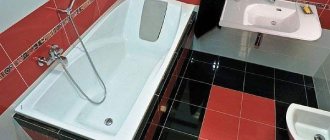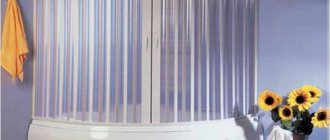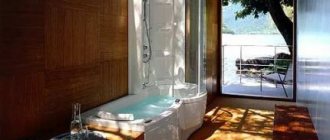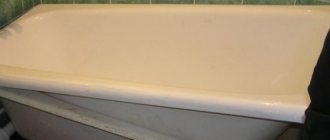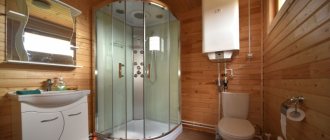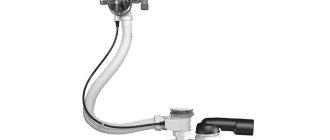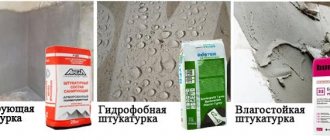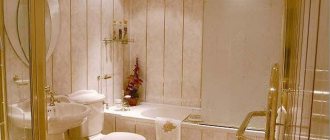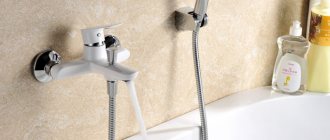Glass brick meets the main requirements for modern finishing materials: durability, practicality and affordable cost. These properties force us to take a fresh look at glass blocks, which have undeservedly lost their popularity. If previously similar “squares” were found mainly in industrial premises and public places (baths, swimming pools, gyms, hospitals), today the scope of glass blocks also extends to residential premises. Modern glass blocks are distinguished by high decorative qualities and improved performance characteristics. Glass brick combines harmoniously with tiles, which allows designers to use it profitably in the bathroom interior.
Glass block: production method, dimensions
A glass block is obtained by connecting two half-blocks of glass 6-7 mm thick. A cavity with rarefied air is formed inside the product. Due to the presence of emptiness, the blocks have low thermal conductivity and high noise insulation.
Glass blocks are produced on automated lines in accordance with GOST 9272-81. The raw materials used are low iron oxide content less than 0.07%. First, semi-blocks are cast from the liquid mass into molds, which are then cooled. The connection of two half-blocks occurs with a welding machine, then the glass product is fired.
The thickness of a glass brick is 75-100 mm, its weight is 2.5-4.3 kg. Standard product dimensions are 190x190x80 mm or 240x240x80 mm. To expand the design possibilities when laying blocks, half-blocks are used, which have dimensions of 190x90x80 mm or 240x115x80 mm.
Glass bricks transmit light just as well as regular glass, but their strength is much higher. The strength allows the material to be used both to create decorative partitions or interior walls in the bathroom, and for the construction of building facades.
Shower project
The design of any shower cabin begins with determining its location and overall dimensions. Then a decision is made:
- by type of pallet;
- material for making the door;
- wall design.
Shower material
At the project stage, it is necessary to calculate the area of the walls that will be mounted from glass blocks. If they exceed 15 m2, it is necessary to apply reinforcement techniques. For this purpose, you can use a steel rod with a diameter of 4-5 mm or ready-made systems (Lux Prof, for example) designed for laying glass blocks.
Varieties
The surface of the glass block can be corrugated or smooth, transparent or matte. Depending on the pattern, the light transmission capacity of the products varies. Therefore they may have:
- translucent structure, characteristic of smooth products. Colorless blocks transmit 80% of light, colored blocks - 50%;
- light guiding structure, characteristic of blocks with a corrugated surface;
- light-diffusing structure, characteristic of matte products, they transmit up to 50% of light.
Smooth glass blocks
Frosted glass blocks
Transparent glass blocks
Corrugated glass blocks
Glass blocks with a pattern
Depending on the desired effect, different types of glass products are used; for example, blocks with different light transmission capacities will be used to make partitions and fill a window opening.
Finished products are produced in the following shapes: rectangular, triangular, square, oval, round. There are also irregularly shaped products and corner elements. Square and rectangular glass blocks are more often used to create straight glass bathroom partitions; corner blocks are used when finishing rotating surfaces and columns. Irregularly shaped products and plexiglass elements are used as decorative inserts.
Glass block shapes
A varied palette of glass block colors allows you to choose the most suitable models for any bathroom. Decorative items have inserts inside in the form of marine-themed items (shells, ships, starfish), birds, flowers, butterflies. High-tech glass bricks with LED lighting elements are also produced.
Pallet
If you choose standard cabin dimensions, you can buy a ready-made pallet - made of acrylic, steel or cast iron.
It is somewhat more difficult to arrange the floor in a cabin with a complex configuration or if, during the design, the dimensions did not fall into the standard line.
A homemade pallet is arranged in the following order:
- Preparatory work is carried out, which consists of dismantling the old floor covering and other layers of the floor structure - right down to its base. All cracks and other defects found on the surface of the reinforced concrete slab are filled with cement and kept until it sets completely.
- The prepared site is covered with a bitumen coating.
- Insulation is laid over the waterproofing (expanded polystyrene rigid boards up to 50 mm thick are suitable). A hole is cut in it for the drain pipe.
- A drain is installed and connected to the sewer pipe.
- A rough cement-sand screed is poured (cement to sand ratio 1:3).
- Additional waterproofing is carried out using isoplast.
- During the process of pouring the finishing screed, a slope of the floor is formed (1 cm by 1 m) towards the drain.
- After curing, glue is applied to the finishing screed and the tiles are laid out.
Shower in the corner
To prevent water from spreading outside the shower stall, you can build a low side by tiling it.
Advantages and disadvantages of glass blocks
The hardness and absolute waterproofness of glass blocks allows them to be used in the interior of wet rooms. However, the main advantages are:
- glass block is non-flammable and can withstand high temperatures for an hour;
- the cavity inside the product provides high sound insulation ability and low thermal conductivity. This allows the material to be used even when constructing external walls;
- the possibility of using the material when zoning premises, ensuring complete or partial insulation of individual sectors;
- the surface of the product does not accumulate odors, does not emit toxins, and is not susceptible to microorganisms;
- no complicated maintenance is required; cleaning with universal glass cleaners is sufficient;
- high light throughput allows you to save energy;
- a variety of decors, combination with plexiglass inserts allows you to create an exclusive individual space;
- it is possible to use blocks for installing interior walls or partitions in darkened rooms, since light will penetrate from one room to another.
The disadvantages of the material include the high cost of high-quality blocks, especially decorative inserts. In addition, the construction of walls using cement mortar takes a long time, since no more than 3 rows can be laid per day. In addition, it is impossible to move a partition made of blocks glued together with a cement composition.
Manufacturers and prices
The building materials market offers products of domestic and imported origin. Glass blocks in Russia are produced at a plant in Bryansk, they have a thickness of 9.8 cm or 7.8 cm, the choice of colors and models is constantly expanding. The Belarusian glass factory in Grodno offers products with wave relief in several colors, the quality of the products is at an average level.
Products from European manufacturers are distinguished by a variety of textures and a choice of shades. Products from the Czech company VitraBlok have rich colors and the best price-quality ratio. Glass blocks from the Italian company Vetroarredo are available in bright and pastel colors, corner elements and round blocks are offered. A partition in the bathroom made of glass blocks from Italian manufacturers will add sophistication to the interior.
From the stained glass blocks of the Italian company Cogir Glass, you can lay out panels with drawings of animals and landscapes. The price of the products is very high, deliveries are made to order. Glass blocks with the best geometry are produced by the German companies Weck and Solaris. The appearance of the products is not inferior to the quality.
An overview of prices for some models of glass blocks from various manufacturers is presented in the table.
| Manufacturer | Relief and color | Price of 1 product, rubles |
| Star Glass (Russia) | Wave, colorless | 70 |
| Star Glass (Russia) | Wave, blue matte | 220 |
| VitraBlok (Czech Republic) | Smooth, colorless | 163 |
| VitraBlok (Czech Republic) | Wave, tarragon | 306 |
| VitraBlok (Czech Republic) | Savona, colorless | 194 |
| Grodno Glass Factory (Belarus) | Wave, colorless | 104 |
| Vetroarredo (Italy) | End wave, blue | 1500 |
| Vetroarredo (Italy) | Wave, Giallo | 280 |
| Solaris (Germany) | Wave, green | 628 |
| Solaris (Germany) | Semicircular with wave, blue | 863 |
| Decorative blocks | from 1500 |
When purchasing glass blocks, you need to check each one separately for chips, microcracks, bubbles on the surface, and examine whether they fog up inside. Defective items can be found even in the collections of famous suppliers.
Possible options for the shape of partitions in the bathroom
If you need to divide the bathroom into several isolated sectors, but at the same time maintain a feeling of free space and create an unusual interior, then it is possible to use glass block partitions in the bathroom. Their shape can be straight or curved, depending on the wishes of the customer and the parameters of the bathroom in which they will be installed. It is easier to erect straight partitions than semicircular ones. To create rotating structures, corner elements are used.
When constructing curved structures, you must follow the following rules:
- to avoid large gaps between blocks, choose a large radius of the partition;
- to create semicircular partitions of small radius, it is recommended to use semi-blocks of small width;
- for large glass blocks, massive partitions with a large radius are designed.
Curved glass block partition
Straight glass block partition
Despite the more complex installation, rounded partitions are erected more often, as they make the movement path as efficient as possible. In addition, contemplation of round objects has a calming effect.
Partitions in the bathroom can be solid or non-solid, with inserts made of decorative elements or plexiglass. Solid ones are installed when creating the walls of a shower stall, separating the location of the bathroom from the washbasin. Non-solid structures have a decorative function and are aimed at highlighting areas, for example, where a bathtub is installed from a washing machine.
In the bathroom it is possible to erect external partitions that will serve as walls. Their advantages are obvious: enough light will penetrate into the room from the outside, there will be no feeling of an enclosed space, and the wall is not completely transparent. This is especially true for small bathrooms.
How to do it yourself?
Installation of shower stalls and glass block corners is best carried out during general renovation of the premises. To avoid unnecessary costs and technical re-equipment of the bathroom, a new shower stall is installed in the place of the old bathtub, so as not to re-arrange the drainage system. When laying glass blocks, the wall must be reinforced.
At the stage of designing a bathroom, even before tiling the walls, it is important to provide places for the outlet of communications under the shower mixer. And then, after completing the masonry work, install the shower stand.
Construction of a shower tray from tiles
A shower tray for a stall is constructed in several ways:
- They purchase a ready-made acrylic structure, install a tray, and trim the side with ceramic tiles.
- Build the pallet yourself from silicate or red brick.
- A monolithic base is erected using a cement-sand mixture.
- A frame podium is mounted from timber, covering it with moisture-resistant material.
Any option for creating a pallet requires preparatory work. The bathroom floor is cleared of debris and existing cracks are filled with cement.
Before constructing the podium, sewerage and water supply pipes are installed, and heat and sound insulation is laid, on top of which a screed is laid. Then a waterproofing layer of coating or film material is applied. Install a shower drain.
At the next stage, the structure is installed relative to the selected option. The side of the shower tray is pre-built from brick, aerated concrete blocks or a metal profile. A cement-sand mortar is placed on top of it. After installing the pallet, lay out ceramic tiles or mosaics, followed by grouting the joints.
Laying the partition
Tools and materials
List of tools:
- drill or hammer drill;
- Master OK;
- level;
- rubber spatula;
- construction marker;
also need the following materials:
- glass blocks;
- ready-mix or cement-sand mortar;
- mounting plastic crosses;
- fiberglass reinforcement bars with a diameter of 6-8 mm;
- grout for blocks.
Oddly enough, fiberglass reinforcement can withstand greater loads than stainless steel reinforcement. It has a lower price and significantly less weight. 100 meters of such rods weigh only 4.5 kg. Therefore, it is better to use fiberglass for reinforcement .
For cement-sand masonry mortar you will need:
- cement - 1 bucket;
- fine washed river sand – 3 buckets;
- purified water – 1 bucket.
To give plasticity, add PVA glue at the rate of 200 g. for 5 buckets of cement mixture. Leave the masonry mortar for 5-10 minutes, then mix thoroughly again.
If you are going to use blocks of light shades, including transparent ones, it is better to use white tile adhesive , then the seams will look more organic.
Instructions
STEP 1. Guide frames or masking adhesive tape, which is needed to mark the installation line of the structure, is placed and secured on the cleaned surface of the pallet side or directly on the floor. The same is done on the vertical surface of the wall to which the partition will be attached.
The junction of the wall and glass blocks can be treated with sand-based primer to increase the reliability of fastening.
STEP 2. Next, you need to lay out the first rad and mark for vertical reinforcement at the junction of the glass blocks. For horizontal rods, make marks on the wall on top of the block.
The holes in the floor for the vertical guides are marked only once. For horizontal ones, mark when laying out each new row.
STEP 3. Now you should drill holes according to the marks. It is necessary to take into account that communications may pass through the wall, so you need to drill to the depth of the tiles and. It would be enough.
STEP 4. Laying begins from the wall to which the shower partition adjoins. A cement-sand mixture or glue is applied to the wall and floor, then the first plastic cross is placed in the corner. Additionally, apply the adhesive mixture to the glass block itself, place it along the markings and press it to the surface. Check the evenness of the installation; if there is a deviation, plastic wedges are inserted under the bottom.
For smooth and high-quality masonry, use special crosses for glass blocks.
The thickness of the seam depends on the size of the blocks themselves. If they are large: 19x19 or 24x24 cm, you can choose 10 mm crosses; if they are small: 11.5x11.5 cm, it is better to choose 5 or 3 mm crosses.
STEP 5. The solution is applied to the side of the next block and placed next to the first, while in the space between them a reinforcing rod is inserted into a pre-drilled hole. Then the upper surface of the blocks is smeared with glue, horizontal reinforcement is placed and placed inside the wall.
STEP 6. The next blocks are installed according to the same principle until the row ends. If the partition being erected has a restriction on only one side, then the opposite end of the reinforcement ends flush with the partition. When laying the blocks, remove excess mixture with a trowel. During this process, the evenness of the structure is periodically checked using a level.
STEP 7. After the first row is ready, perform the second and third. After laying the third row, it is recommended to take a break so that the mixture or glue has time to harden, ensuring the strength of the structure. When using tile adhesive, the break lasts 5 hours, if cement-sand mortar is used - 1 day. After the solution has dried, the remaining rows are laid out in a similar way until the partition reaches the desired height.
STEP 8. There are several ways to improve the ends of a shower partition. Firstly, there are special end rounded blocks that are placed at the end of the row.
Everything is simple here. Secondly, there are glass plates, which are attached to pre-aligned ends using mirror glue.
STEP 9. At the last stage, remove the plastic crosses and seal the gaps with a special grout mixture using a rubber spatula. Then the seams are leveled, the protective film is removed and the blocks are cleaned of dust and dirt. Acetic acid is used to remove excess glue or solution. Using water repellents, the seams are protected from water.
If the partition has a curved design, then the reinforcement bars are bent according to the shape of the wall, and the radius should not be more than 5 m. During installation, plastic crosses are placed only inside the curve. For curved partitions, it is recommended to use smaller blocks to create a smooth turn, and for strength, use more reinforcing bars.
STEP 10. When the partition is ready, you can leave the entrance to the resulting booth open, but to avoid splashes on the floor, it is better to install a glass door. To do this, measure the distance between the partition and the opposite wall, and then select a door in the store, or order individual production according to the specified dimensions.
The installation is simple. Mark the fastenings for the hinges on the wall and drill holes for the dowels. Then the door sits on its hinges.
Color solution
Partitions of any shape are assembled from glass bricks, which can be of different colors. Colorless glass blocks are the most popular, as they transmit the maximum color, and are also the most inexpensive. They will suit any interior, and if you change the design of the walls, you don’t have to change the partition.
To decorate colorless structures, decorative inserts made of plexiglass, colored, textured glass blocks or elements with decor made of stones, shells, and dried flowers inside are used. Decorative blocks with a drop pattern are often used for shower partitions.
Colored products have a wide selection of shades and reliefs. They allow you to create a dynamic and bright interior. The light transmittance of painted blocks is 35-50%, which determines their use for separating areas that require privacy.
Color blocks from different batches may have different shades, so it is recommended to purchase the required quantity with a small margin in case the elements are damaged during installation.
Glass bathroom partitions made from clear glass blocks can be decorated using artistic painting techniques. Drawings based on individual sketches can create a unique interior in the bathroom. The basic rule of decor is moderation.
Colorless glass blocks
Glass blocks with decorative elements
Colored glass blocks
